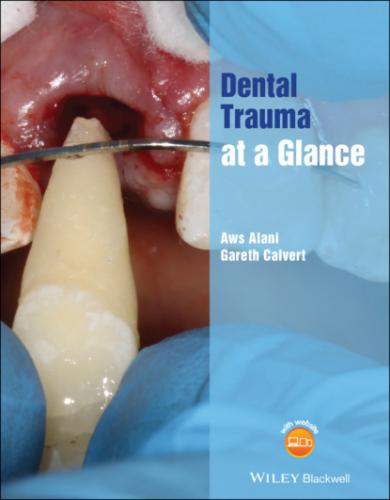Aws Alani
About the companion website
Don't forget to visit the companion website for this book:
www.wiley.com/go/alani/dental_trauma
There you will find valuable materials, including:
Figures from within the book
MCQs
Scan this QR code to visit the companion website:
1 Risk factors for dental trauma
Figure 1.1 Demonstration of a 6mm overjet.
Figure 1.2 Lower lip trapped behind the maxillary incisor.
Figure 1.3 A heavily restored dentition following dental trauma with numerous fractured and decemented restorations.
Figure 1.4 Dental trauma caused by sporting activities, in this case boxing.
Figure 1.5 Dental trauma caused by a road traffic accident presenting 2 years later with severe hard and soft tissue defects.
Introduction
With any acquired defects or injuries, the basis for management is the identification of risk factors and their reduction to maximise preventative strategies. By instigating awareness amongst the public, injuries can be avoided, and the burden of their management during the patient’s life can be mitigated or completely removed. At worst, the severity of injuries can be reduced, making them easier to manage and resolve. Dental trauma injuries such as avulsion or intrusion can be complicated and challenging for the clinician, whereas conditions that involve luxation type injuries are easier to plan and manage future physiological or biological changes during the lifetime of the patient. The following are common risk factors (Glendor 2009).
Oral predisposing factors
Patients with an overjet of 6 mm or greater (Figure 1.1).
Lip incompetence (Figure 1.2).
Protruding upper anterior teeth.
Patients with residual dental disease, such as heavily restored teeth or periodontitis, are more likely to suffer greater consequences of trauma than those with otherwise intact healthy dentitions (Figure 1.3).
Unintentional traumatic dental injuries
Formulates a large cohort of dental injuries.
Patients prone to falling over due to medical conditions or those that may be at a greater risk due to seizures such as epilepsy may present multiple times throughout their lives.
Sports that involve projectile equipment such as hockey, cricket, or football are also at a greater risk. Ice hockey has been shown to have the highest prevalence of all sports.
Contact sports such as boxing and martial arts also carry an increased risk. Non‐contact sports such as gymnastics, horse riding, and athletics also represent a risk.
Socioeconomic factors
There is some evidence that shows areas with greater deprivation have a higher prevalence of trauma.
Densely populated areas also show a greater prevalence.
Human behaviour
Patients who take risks with their physical safety are at a greater risk of dental trauma (Figure 1.4).
Situations of greater interpersonal difficulty such as being bullied have a higher risk of dental trauma.
Patients who are hyperactive, such as those with Attention deficit hyperactivity disorder or ADHD, are at a greater risk of dental trauma.
Inappropriate use of teeth such as the opening of bottles or beverages also has a higher risk of dental trauma.
Learning difficulties or physical limitations
Epilepsy, cerebral palsy, learning difficulties, or hearing or visual impairment all present a greater risk of dental trauma.
Intentional traumatic dental injuries
Interpersonal violence such as physical abuse between partners or assault increases the risk of dental trauma.
Clinicians must be vigilant for signs of physical abuse and consider liaising with their local safeguarding team or seeking advice from the Police.
Iatrogenic injuries
One of the most common complications of general anaesthesia is dental trauma during intubation procedures.
Road traffic accidents
More severe traumatic dental injuries are likely in road traffic accidents. Due to
